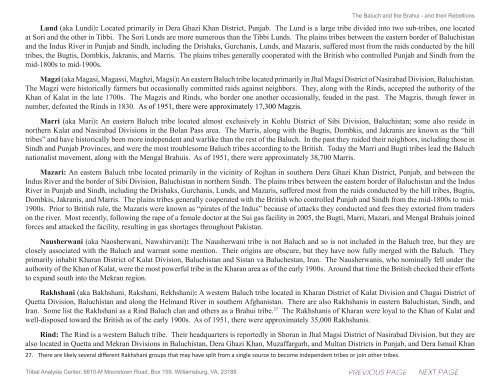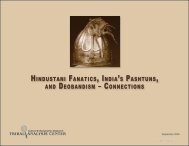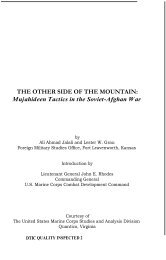the baluch and the brahui and their rebellions - Tribal Analysis Center
the baluch and the brahui and their rebellions - Tribal Analysis Center
the baluch and the brahui and their rebellions - Tribal Analysis Center
Create successful ePaper yourself
Turn your PDF publications into a flip-book with our unique Google optimized e-Paper software.
The Baluch <strong>and</strong> <strong>the</strong> Brahui - <strong>and</strong> <strong>the</strong>ir RebellionsLund (aka Lundi): Located primarily in Dera Ghazi Khan District, Punjab. The Lund is a large tribe divided into two sub-tribes, one locatedat Sori <strong>and</strong> <strong>the</strong> o<strong>the</strong>r in Tibbi. The Sori Lunds are more numerous than <strong>the</strong> Tibbi Lunds. The plains tribes between <strong>the</strong> eastern border of Baluchistan<strong>and</strong> <strong>the</strong> Indus River in Punjab <strong>and</strong> Sindh, including <strong>the</strong> Drishaks, Gurchanis, Lunds, <strong>and</strong> Mazaris, suffered most from <strong>the</strong> raids conducted by <strong>the</strong> hilltribes, <strong>the</strong> Bugtis, Dombkis, Jakranis, <strong>and</strong> Marris. The plains tribes generally cooperated with <strong>the</strong> British who controlled Punjab <strong>and</strong> Sindh from <strong>the</strong>mid-1800s to mid-1900s.Magzi (aka Magasi, Magassi, Maghzi, Magsi): An eastern Baluch tribe located primarily in Jhal Magsi District of Nasirabad Division, Baluchistan.The Magzi were historically farmers but occasionally committed raids against neighbors. They, along with <strong>the</strong> Rinds, accepted <strong>the</strong> authority of <strong>the</strong>Khan of Kalat in <strong>the</strong> late 1700s. The Magzis <strong>and</strong> Rinds, who border one ano<strong>the</strong>r occasionally, feuded in <strong>the</strong> past. The Magzis, though fewer innumber, defeated <strong>the</strong> Rinds in 1830. As of 1951, <strong>the</strong>re were approximately 17,300 Magzis.Marri (aka Mari): An eastern Baluch tribe located almost exclusively in Kohlu District of Sibi Division, Baluchistan; some also reside innor<strong>the</strong>rn Kalat <strong>and</strong> Nasirabad Divisions in <strong>the</strong> Bolan Pass area. The Marris, along with <strong>the</strong> Bugtis, Dombkis, <strong>and</strong> Jakranis are known as <strong>the</strong> “hilltribes” <strong>and</strong> have historically been more independent <strong>and</strong> warlike than <strong>the</strong> rest of <strong>the</strong> Baluch. In <strong>the</strong> past <strong>the</strong>y raided <strong>the</strong>ir neighbors, including those inSindh <strong>and</strong> Punjab Provinces, <strong>and</strong> were <strong>the</strong> most troublesome Baluch tribes according to <strong>the</strong> British. Today <strong>the</strong> Marri <strong>and</strong> Bugti tribes lead <strong>the</strong> Baluchnationalist movement, along with <strong>the</strong> Mengal Brahuis. As of 1951, <strong>the</strong>re were approximately 38,700 Marris.Mazari: An eastern Baluch tribe located primarily in <strong>the</strong> vicinity of Rojhan in sou<strong>the</strong>rn Dera Ghazi Khan District, Punjab, <strong>and</strong> between <strong>the</strong>Indus River <strong>and</strong> <strong>the</strong> border of Sibi Division, Baluchistan in nor<strong>the</strong>rn Sindh. The plains tribes between <strong>the</strong> eastern border of Baluchistan <strong>and</strong> <strong>the</strong> IndusRiver in Punjab <strong>and</strong> Sindh, including <strong>the</strong> Drishaks, Gurchanis, Lunds, <strong>and</strong> Mazaris, suffered most from <strong>the</strong> raids conducted by <strong>the</strong> hill tribes, Bugtis,Dombkis, Jakranis, <strong>and</strong> Marris. The plains tribes generally cooperated with <strong>the</strong> British who controlled Punjab <strong>and</strong> Sindh from <strong>the</strong> mid-1800s to mid-1900s. Prior to British rule, <strong>the</strong> Mazaris were known as “pirates of <strong>the</strong> Indus” because of attacks <strong>the</strong>y conducted <strong>and</strong> fees <strong>the</strong>y extorted from traderson <strong>the</strong> river. Most recently, following <strong>the</strong> rape of a female doctor at <strong>the</strong> Sui gas facility in 2005, <strong>the</strong> Bugti, Marri, Mazari, <strong>and</strong> Mengal Brahuis joinedforces <strong>and</strong> attacked <strong>the</strong> facility, resulting in gas shortages throughout Pakistan.Nausherwani (aka Naosherwani, Nawshirvani): The Nausherwani tribe is not Baluch <strong>and</strong> so is not included in <strong>the</strong> Baluch tree, but <strong>the</strong>y areclosely associated with <strong>the</strong> Baluch <strong>and</strong> warrant some mention. Their origins are obscure, but <strong>the</strong>y have now fully merged with <strong>the</strong> Baluch. Theyprimarily inhabit Kharan District of Kalat Division, Baluchistan <strong>and</strong> Sistan va Baluchestan, Iran. The Nausherwanis, who nominally fell under <strong>the</strong>authority of <strong>the</strong> Khan of Kalat, were <strong>the</strong> most powerful tribe in <strong>the</strong> Kharan area as of <strong>the</strong> early 1900s. Around that time <strong>the</strong> British checked <strong>the</strong>ir effortsto exp<strong>and</strong> south into <strong>the</strong> Mekran region.Rakhshani (aka Bakhshani, Rakshani, Rekhshani): A western Baluch tribe located in Kharan District of Kalat Division <strong>and</strong> Chagai District ofQuetta Division, Baluchistan <strong>and</strong> along <strong>the</strong> Helm<strong>and</strong> River in sou<strong>the</strong>rn Afghanistan. There are also Rakhshanis in eastern Baluchistan, Sindh, <strong>and</strong>Iran. Some list <strong>the</strong> Rakhshani as a Rind Baluch clan <strong>and</strong> o<strong>the</strong>rs as a Brahui tribe. 27 The Rakhshanis of Kharan were loyal to <strong>the</strong> Khan of Kalat <strong>and</strong>well-disposed toward <strong>the</strong> British as of <strong>the</strong> early 1900s. As of 1951, <strong>the</strong>re were approximately 35,000 Rakhshanis.Rind: The Rind is a western Baluch tribe. Their headquarters is reportedly in Shoran in Jhal Magsi District of Nasirabad Division, but <strong>the</strong>y arealso located in Quetta <strong>and</strong> Mekran Divisions in Baluchistan, Dera Ghazi Khan, Muzaffargarh, <strong>and</strong> Multan Districts in Punjab, <strong>and</strong> Dera Ismail Khan27. There are likely several different Rakhshani groups that may have split from a single source to become independent tribes or join o<strong>the</strong>r tribes.<strong>Tribal</strong> <strong>Analysis</strong> <strong>Center</strong>, 6610-M Mooretown Road, Box 159. Williamsburg, VA, 23188
















